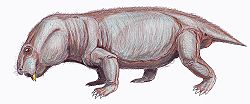| Peramodon Temporal range: Late Permian ~ | |
|---|---|
 | |
| Life restoration | |
| Scientific classification | |
| Domain: | Eukaryota |
| Kingdom: | Animalia |
| Phylum: | Chordata |
| Clade: | Synapsida |
| Clade: | Therapsida |
| Suborder: | † Anomodontia |
| Clade: | † Dicynodontia |
| Infraorder: | † Dicynodontoidea |
| Genus: | † Peramodon Kammerer et al. 2011 |
| Type species | |
| †P. amalitzkii (Sushkin 1926) | |
Peramodon is an extinct genus of dicynodont therapsid from the Late Permian Scutosaurus karpinskii Zone of the Salarevo Formation of Russia. [1] The type species, P. amalitzkii, was first named in 1926 as Dicynodon amalitzkii.





